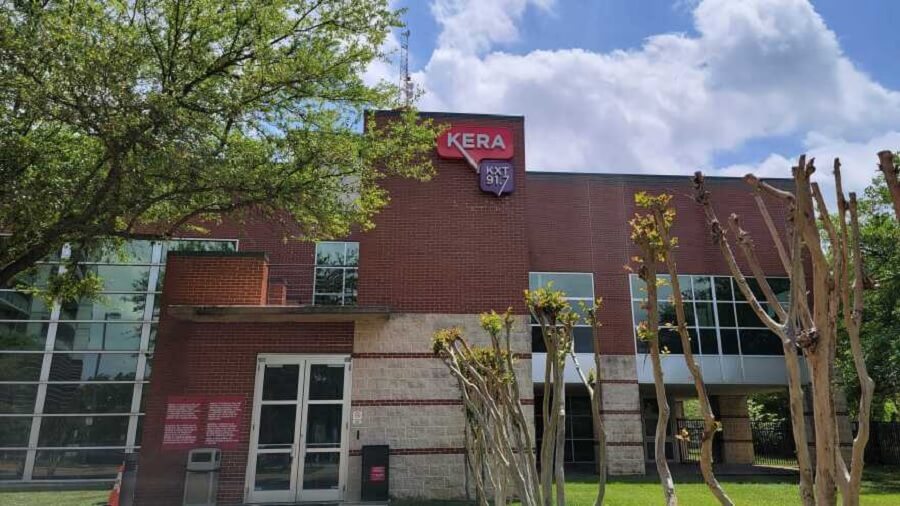Bob Ray Sanders remembers the moment KERA 90.1 FM was switched on the air on July 11, 1974.
At the time, the station’s management was cautiously optimistic about starting up a public radio station in a media market with so much competition.
“People weren’t sure that it would work here,” Sanders said. “Who would want to listen to a public radio station?”
Fifty years later, 90.1 FM is still going strong, broadcasting quality local, national and international news to hundreds of thousands of North Texas listeners each day.
The early years
KERA-FM’s legacy as a North Texas establishment began with its famously humble beginnings broadcasting out of the Little Red Schoolhouse with a small but dedicated staff. The building was donated by the Dallas Independent School District and housed KERA-TV, which had gone on air in 1960.
Among the station’s first staff was Sanders, who began his career with KERA in 1969 as a reporter and eventually became the station’s manager. Back then, he said, the radio station worked in conjunction with KERA’s signature TV show Newsroom, which was known for its hard-hitting reports on Dallas City Hall, county courts and race relations.
“We challenged people, and would go on every day and every night telling people in Dallas-Fort Worth what we thought they should know about those issues,” Sanders said.

As station manager, Sanders was also involved in conversations that led to the launch of NPR’s Morning Edition on local member stations.
“Most of the stations in the country did not want a new show in the morning. They were fine with their classical music,” Sanders said. “We were in a meeting in Washington with NPR and were one of the first to say, ‘Yes, we will take a new show.’”
By 1990, Sanders had moved on to other opportunities, but in his time at KERA, he inspired a new generation of listeners and journalists — like Yolette Garcia, who remembers listening to the station while writing her master’s thesis as a student at Southern Methodist University.
The next generation
Garcia began working at KERA in 1983, filling various roles in both radio and television. She eventually became the radio station’s news director. Her news team covered evolving issues as they unfolded, including the police shootings of Black elderly residents in Dallas that ultimately led to congressional hearings.
“That issue kind of made us put our best foot forward for the rest of the time that we were dealing with coverage, because we learned a lot,” Garcia said. “We knew what we had to do to make it fair. The city was not in good shape.”
Among the colleagues Garcia remembers were Marla Crockett, host of KERA’s Morning Edition, and reporter Tom Olsen, who covered Dallas City Hall. Garcia said Olsen was a dedicated reporter; he was diagnosed with AIDS and later passed away from the disease.
She recalls the moment when he asked her if he could say goodbye to his listeners.
“He got on the air, and it took a lot of courage to say, ‘I am a reporter. That’s who I am, but I also have AIDS and I can no longer report.’ It was one of the most moving things that I had heard,” Garcia said. “This is only possible, I think, in public radio.”
Garcia added that KERA made strong efforts to include diverse voices in the newsroom.
“If you compared how we looked versus other newsrooms, I think you could see that there,” Garcia said. “It’s something that the station believed in.”
Garcia said among the many projects she worked on, Project Crossroads is one that she’s most proud of, which focused on the intersection of religion and race in the greater Dallas area.
The 1990s to present day
Moving into the 1990s, KERA-FM was still broadcasting under a news and music format that included a variety of genres and a rotating roster of DJs. Among them were the late Dennis Gonzalez, host of the late-night experimental jazz show Miles Out, and Abby Goldstein, host of the Texas-music show Lone Star Saturday Night.
Goldstein — who eventually became the station’s program director — recalls the acts that would visit the station during her time as a DJ, including artists like Lyle Lovett and Sarah McLachlan.

“We were the first station in Dallas-Fort Worth to play the Dave Matthews Band,” Goldstein said. “It was a station that was instrumental in breaking artists and breaking bands at a time when radio dominated in that space.”
She said KERA-FM was a station known for embracing local music early on, but in the late 1990s the station changed its format to news-only, a decision that ultimately led to the creation of its sister station, KXT.
“It’s clear that the station made the right decision at the right time,” Goldstein said.
By the late 90s the station had moved into its current building at 3000 Harry Hines Boulevard.
In the newsroom, the station had hired talented journalists such as Sam Baker and Bill Zeeble, who would become — and remain— recognized voices on the air. The station also had a long-running talk show hosted by the late Glenn Mitchell.
Jeff Whittington joined KERA in 1997 as an events planner and worked with Mitchell before he died unexpectedly in 2005.
“Glenn could ask incredibly insightful, but very brief questions,” Whittington said. “He really was a master at getting his guests to tell the story.”
In 2006, Whittington co-created and helped launch Think, which would become KERA’s flagship midday show now broadcast at public radio stations across the country. But as North Texas’ population began to grow exponentially, so did the region’s need for greater news coverage.
By 2012, the station had hired Rick Holter, who expanded the news team. Whittington recalls working on news projects during a tumultuous news cycle that included the Ebola outbreak in 2014 and the deadly Dallas police shooting in 2016, both stories that became national news. The station won several awards for its coverage of those events.
“We stepped up to make sure we were there to cover that news for people, not just in North Texas, not just the people who supported KERA and listened to us on the air, but people all over the country,” Whittington said.
He said what makes him the most proud about the station is working with the many interns who went on to become full-time public media journalists (including yours truly).
Today the KERA newsroom continues to provide the award-winning quality storytelling and hard-hitting news coverage that has been a part of its legacy since it first hit the airwaves in 1974. The news team has grown from just two reporters to almost 20, along with more than two dozen producers, hosts and editors.
In just a few short years, the station has expanded its on-air and digital presence in the region as it provides coverage not just to Dallas, but to listeners and readers in Fort Worth, Collin County, Denton and Arlington. It’s also getting a new building, which is expected to open sometime in the coming years.
Now 50 years strong, KERA-FM continues to be a glowing pillar of North Texas media that will — hopefully — keep shining on for another half-century.
source










